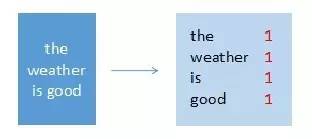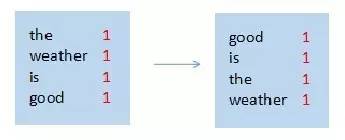Hadoop,mapreduce 介绍
59888745@qq.com
大数据工程师是在Linux系统下搭建Hadoop生态系统(cloudera是最大的输出者类似于Linux的红帽),
把用户的交易或行为信息通过HDFS(分布式文件系统)等存储用户数据文件,然后通过Hbase(类似于NoSQL)等存储数据,再通过Mapreduce(并行计算框架)等计算数据,然后通过hiv或pig(数据分析平台)等分析数据,最后按照用户需要重现出数据.
Hadoop是一个由Apache基金会所开发的开源分布式系统基础架构
Hadoop,最基础的也就是HDFS和Mapreduce了,
HDFS是一个分布式存储文件系统
Mapreduce是一个分布式计算的框架,两者结合起来,就可以很容易做一些分布式处理任务了
大纲:
一、MapReduce 基本原理
二、MapReduce 入门示例 - WordCount 单词统计
三、MapReduce 执行过程分析
-
实例1 - 自定义对象序列化
-
实例2 - 自定义分区
-
实例3 - 计算出每组订单中金额最大的记录
-
实例4 - 合并多个小文件
-
实例5 - 分组输出到多个文件
四、MapReduce 核心流程梳理
-
实例6 - join 操作
-
实例7 - 计算出用户间的共同好友
五、下载方式
一、MapReduce基本原理
MapReduce是一种编程模型,用于大规模数据集的分布式运算。
1、MapReduce通俗解释
图书馆要清点图书数量,有10个书架,管理员为了加快统计速度,找来了10个同学,每个同学负责统计一个书架的图书数量。
张同学统计 书架1
王同学统计 书架2
刘同学统计 书架3
……
过了一会儿,10个同学陆续到管理员这汇报自己的统计数字,管理员把各个数字加起来,就得到了图书总数。
这个过程就可以理解为MapReduce的工作过程。
2、MapReduce中有两个核心操作
(1)map
管理员分配哪个同学统计哪个书架,每个同学都进行相同的“统计”操作,这个过程就是map。
(2)reduce
每个同学的结果进行汇总,这个过程是reduce。
3、MapReduce工作过程拆解
下面通过一个景点案例(单词统计)看MapReduce是如何工作的。
有一个文本文件,被分成了4份,分别放到了4台服务器中存储
Text1:the weather is good
Text2:today is good
Text3:good weather is good
Text4:today has good weather
现在要统计出每个单词的出现次数。

处理过程
(1)拆分单词
-
map节点1
输入:“the weather is good”
输出:(the,1),(weather,1),(is,1),(good,1)

-
map节点2
输入:“today is good”
输出:(today,1),(is,1),(good,1)

-
map节点3
输入:“good weather is good”
输出:(good,1),(weather,1),(is,1),(good,1)

-
map节点4
输入:“today has good weather”
输出:(today,1),(has,1),(good,1),(weather,1)

(2)排序
-
map节点1

-
map节点2

-
map节点3

-
map节点4

(3)合并
-
map节点1

-
map节点2

-
map节点3

-
map节点4

(4)汇总统计
每个map节点都完成以后,就要进入reduce阶段了。
例如使用了3个reduce节点,需要对上面4个map节点的结果进行重新组合,比如按照26个字母分成3段,分配给3个reduce节点。
Reduce节点进行统计,计算出最终结果。

这就是最基本的MapReduce处理流程。
4、MapReduce编程思路
了解了MapReduce的工作过程,我们思考一下用代码实现时需要做哪些工作?
-
在4个服务器中启动4个map任务
-
每个map任务读取目标文件,每读一行就拆分一下单词,并记下来次单词出现了一次
-
目标文件的每一行都处理完成后,需要把单词进行排序
-
在3个服务器上启动reduce任务
-
每个reduce获取一部分map的处理结果
-
reduce任务进行汇总统计,输出最终的结果数据
但不用担心,MapReduce是一个非常优秀的编程模型,已经把绝大多数的工作做完了,我们只需要关心2个部分:
-
map处理逻辑——对传进来的一行数据如何处理?输出什么信息?
-
reduce处理逻辑——对传进来的map处理结果如何处理?输出什么信息?
编写好这两个核心业务逻辑之后,只需要几行简单的代码把map和reduce装配成一个job,然后提交给Hadoop集群就可以了。
至于其它的复杂细节,例如如何启动map任务和reduce任务、如何读取文件、如对map结果排序、如何把map结果数据分配给reduce、reduce如何把最终结果保存到文件等等,MapReduce框架都帮我们做好了,而且还支持很多自定义扩展配置,例如如何读文件、如何组织map或者reduce的输出结果等等,后面的示例中会有介绍。
二、MapReduce入门示例:WordCount单词统计
WordCount是非常好的入门示例,相当于helloword,下面就开发一个WordCount的MapReduce程序,体验实际开发方式。
example:
#删除已有文件夹
hadoop fs -rmr /chenshaojun/input/example_1
hadoop fs -rmr /chenshaojun/output/example_1
#创建输入文件夹
hadoop fs -mkdir /chenshaojun/input/example_1
#放入输入文件
hadoop fs -put text* /chenshaojun/input/example_1
#查看文件是否放好
hadoop fs -ls /chenshaojun/input/example_1
#本地测试一下map和reduce
head -20 text1.txt | python count_mapper.py | sort | python count_reducer.py
#集群上跑任务
hadoop jar /usr/lib/hadoop-current/share/hadoop/tools/lib/hadoop-streaming-2.7.2.jar
-file count_mapper.py #提交文件到集群
-mapper count_mapper.py
-file count_reducer.py
-reducer count_reducer.py
-input /chenshaojun/input/example_1
-output /chenshaojun/output/example_1 # 必须不存在,若存在output会抱错,不会覆盖
count_mapper.py
import sys
# input comes from STDIN (standard input)
for line in sys.stdin:
# remove leading and trailing whitespace
line = line.strip()
# split the line into words
words = line.split()
# increase counters
for word in words:
# write the results to STDOUT (standard output);
# what we output here will be the input for the
# Reduce step, i.e. the input for reducer.py
#
# tab-delimited; the trivial word count is 1
print '%s %s' % (word.lower(), 1)
count_reducer.py
from operator import itemgetter
import sys
current_word = None
current_count = 0
word = None
# input comes from STDIN
for line in sys.stdin:
# remove leading and trailing whitespace
line = line.strip()
# parse the input we got from mapper.py
word, count = line.split(' ', 1)
# convert count (currently a string) to int
try:
count = int(count)
except ValueError:
# count was not a number, so silently
# ignore/discard this line
continue
# this IF-switch only works because Hadoop sorts map output
# by key (here: word) before it is passed to the reducer
if current_word == word:
current_count += count
else:
if current_word:
# write result to STDOUT
print '%s %s' % (current_word, current_count)
current_count = count
current_word = word
# do not forget to output the last word if needed!
if current_word == word:
print '%s %s' % (current_word, current_count)